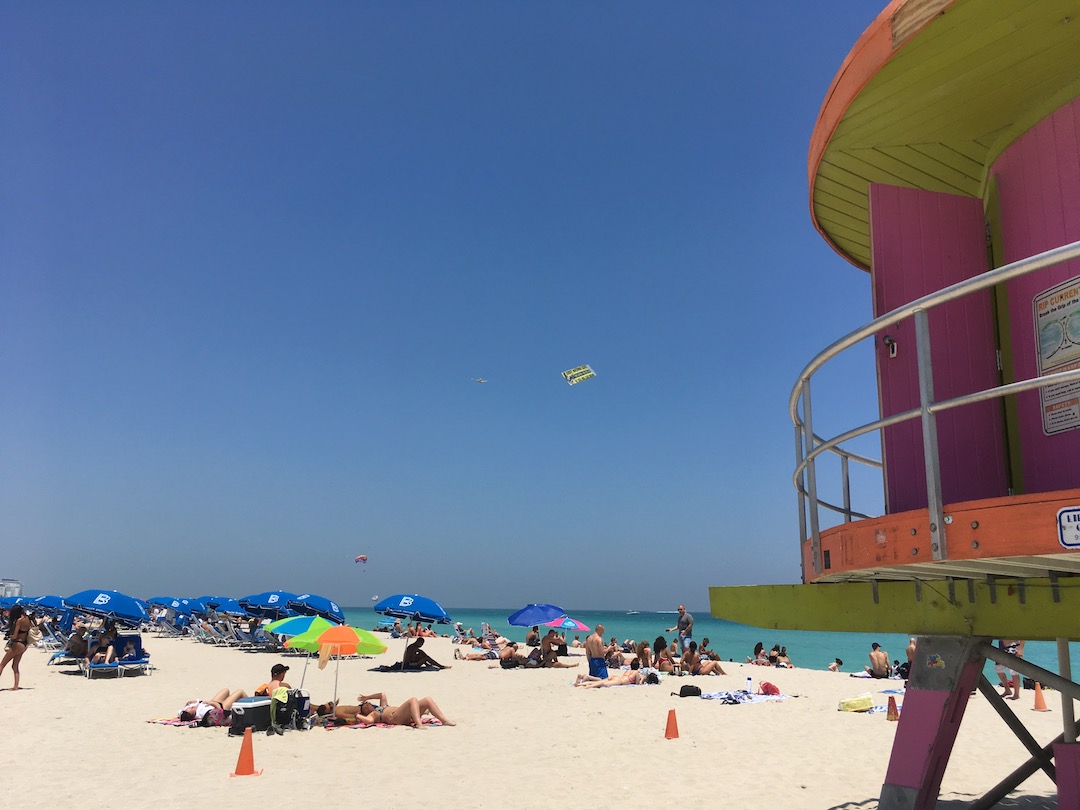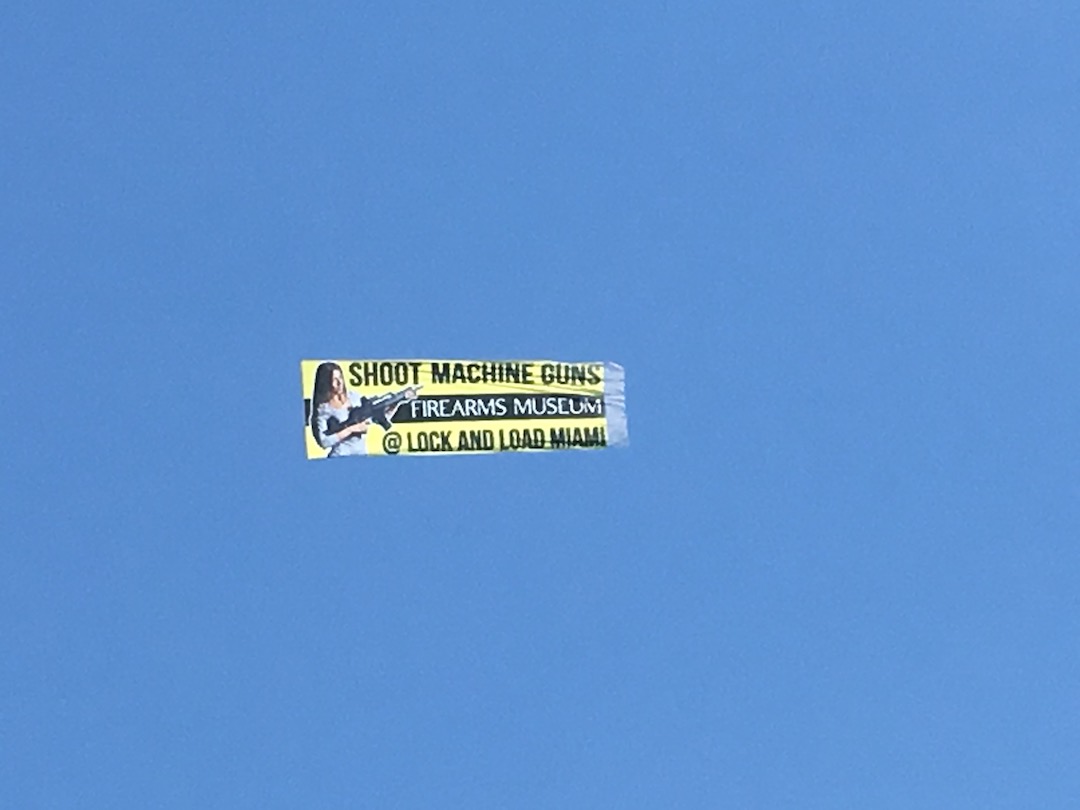HAVANA — We went to Cuba! On our return, family and friends wanted to know all about it. “How was the food in Havana?” has been the most frequent question. Our answer: We barely ate on the island, not a satisfactory response for us, either.
What can my wife or I report? I didn’t lose my wallet at customs, and I was not mugged behind the mausoleum.

Photo Christy K. Pollock
We went more as tourists than travelers, a silver anniversary cruise, so the passage was half the time and half the fun of the trip, not just conveyance. After 25 years, even before our second date two years earlier, I learned not to speak on behalf of My Beloved (MB). These are my perceptions. Going by the draft’s word count, I have some.
A few months after the trip, I can’t make this a travelogue. Like any other writer with any other destination, it’s all been said before. Reflective anecdotes I’ve got, though.
I did not approach the visit as a journalist, nor could I have done much, by my standards, as a professional observer. Yet after decades in news media I can’t help but watch, question, take notes and try to figure things out. When you share what you’ve learned, it’s journalism. Might be less than first-rate, but it’s real.
Our long-planned second honeymoon happened to overlap the day, April 19, 2018, when Raul Castro with little if any notice retired from the office his brother Fidel held for decades before him. Raul’s vice president, Miguel Diaz-Canel, succeeded him. Find journalism on this at “Castro Steps Down as Díaz-Canel Assumes Cuban Presidency” and “Cuba’s New Leader Vows to Modernise Economy but No Return to Capitalism.”
We almost had no idea anything was happening. The guide for our afternoon bus tour of Havana historic sites mentioned that “tomorrow,” Wednesday, April 18, was going to be important as a new vice president was to be announced. I don’t know if the guides on the excursion’s other seven buses informed their passengers. MB later asked the guide for our evening nightclub excursion, and he knew only about the same.
The Norwegian Cruise Line ship had few channels on the stateroom TV sets so I watched MSNBC and BBC, avoiding Fox News. CNN was not available. Nothing off the boat was in the daily schedule handout so no word on Cuban politics. Late Thursday, though, BBC ran three words on the bottom screen crawl, “Raul Castro Retires.”
Internet on board cost $35 a day, so we decided to take a social media holiday. Did you miss us April 16-20?
The tour guides didn’t have it quite right. Days later Diaz-Canal announced his second in command. Actually, he named six vice presidents, The New York Times reported April 22. It wasn’t clear if among them there’s a first vice president.
We American and European tourists saw no change from the leadership transition Wednesday. This is Ben Pollock live, reporting to you from Havana Harbor.
We arrived in Havana Harbor on Tuesday morning. We had chosen a bus tour of 15th-17th-century Spanish ruins, a variety of residential neighborhoods from poor/working to middle class, and commercial and public facilities. Their Capitol resembles the U.S. one, but is this much taller, the guide said, spreading her thumb and index finger, apparently a common joke delivered to foreign tourists.
On the road were Cuba’s famous old cars. Due to decades of restrictions and embargoes, drivers generally have had autos from the 1950s at the latest, repairing them as needed. The shinier of these classics, often convertibles, were used as tourist taxis, hired by some of our shipmates. Commuting Cubans may have waxed less, but their motors all purred. Well, every few blocks there was a car on the shoulder with a sweaty man leaning under the raised hood. Note: no air-conditioning in these babies, so their windows always were open in the tropical heat.
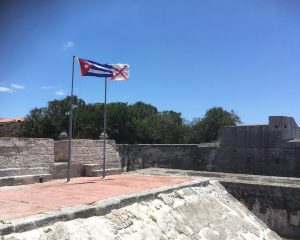
Photo Ben Pollock
The second walking stop was at a never-used Spanish fort, pictured. The earlier was for a walk through the Cristobal Colon (Christopher Columbus) Cemetery. No, he’s not buried there but we wanted him in, was a quip of our guide, as Chris is blamed for the island’s historic troubles. Several Caribbean nations, she added, have Columbus cemeteries as well, and his remains are in none of them.
The cemetery was the burial place of Cuban heroes, both recent and further back, such as Jose Marti (1853-1895). “Cuban Poet José Martí: Everyone’s Revolutionary,” reported The New York Times in 2016, when President Barack Obama further opened relations with Cuba. (Che’s buried 270 miles east in Santa Clara.)
The memorials are fascinating, with unique statues and various styles of mausoleums. The guide said that despite appearances the Cuban people do not obsess with death, compared to Americans (us) and our leaving flowers, flags and so on.
Meanwhile, MB was waylaid in our bus — she was in the bus’s restroom when we stopped at the cemetery. All of us got out, and the bus went on about a half-mile up the drive to the chapel, toward which we were to walk, stopping at certain graves along the way. That’s when MB was able to get out, walk back to our group, then stroll with us back to the chapel. So she missed the initial sets of comments about this military hero or that writer.
A few of us, restless and curious, walked around during the narration, examining monuments.
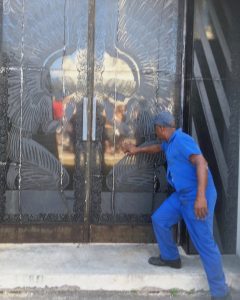
Photo Ben Pollock
One mausoleum struck me, with dark granite (unusual in this graveyard) with a nouveau/deco stying so I approached it with my cellphone camera app on.
A worker, in the blue work shirt and trousers of all the cemetery crew, beckoned me. I followed with no thought or apprehension, although in the very moment visualized the diner scene in Mulholland Drive, where one guy is telling another about his dream of a scary creature behind the cafe so the two go back there and. …
My trusting physical intuition was right — the worker just wanted to point out better photo vantage points and, yes, in exchange for $5 U.S., no Cuban pesos for him. It turns out this mausoleum was somewhat wrecked in the back. The worker gestured I should look in an iron-barred, glassless window. It was a bit high, so the worker pointed to where I could step up. He steadied me with a hand to the small of my back. It was a strong confident touch. I felt no fear. Inside the back of the little building was broken concrete.

Photo Ben Pollock
My photos turned out fuzzy, just as well, nothing to see here.
The old Spanish fort, after we were bused further through Havana, was authentically 16th century but never used militarily. What it had besides a grand view, from a high point, was a government cigar and rum store for us tourists.
MB bought some Havanas, and I snapped a photo of Russian leader Vladimir Putin that was hanging above the cash register.
The cashier glared at me when I did so.
Customs at the dock was smooth. A row of glass-fronted booths held Cuban customs agents, and security on the Cuban side resembled that of an airport. Returning from the city, we emptied pockets to waiting plastic bins and placed bags on the conveyor belt. We could hold valuables as we walked through the X-ray machine. I would grip my money wallet and passport wallet, wait in line and go through. Then we repacked our pockets.
Once on the ship side following the Tuesday afternoon bus tour, I routinely felt my pockets and my money wallet was — was where?
I remembered — I had counted two items to hold and it must’ve been the passport wallet but unexpectedly also the coin case. I returned through a customs booth, and a smiling Cuban security agent pointed me to a table when another guard was inventorying every bill and card, listing each on a paper form. I couldn’t reclaim them until she was done, and she was methodical. But eventually, she had me initial at several spots then sign.
Absolutely nothing was taken. By my experiences, Cuban people are friendly, courteous and honest.
We returned to the ship to rest and for a good, conventional dinner (the cruise liner generally accommodated our vegan diet well) then headed out at 9:45 (Eastern) for a late club date. We chose a successor band to the Buena Vista Social Club, while other shipmates chose a Las Vegas style showgirl extravaganza. The latter is not out of line, as it would be similar to what was offered to visitors during the Batista regime post World War II. We boarded a bus for the Habana Café at the Melia Cohiba Hotel.
Outside of the headline act, one cocktail and appetizer trays to be included in the price of the excursion, we didn’t know what to expect. MB loved her mojito. We were served cheese and sausage platters. Though vegan, I tried some for research. I’m still cured of meat.
On stage was a string quintet of five teenage girls — two violins, viola, cello and upright bass — playing light classical excerpts and some jazz swing. In the last couple of numbers, some of them sang Big Band numbers, perhaps “Boogie Woogie Bugle Boy.” The ensemble played very well, for an amateur high school group.
Our top of the bill show was exactly what we hoped.
The “social club” stars comprised old timers hale enough to perform. Above them was a screen showing slides of folks in their 1950s pre-Castro heyday. The only one from that generation was a marvelous woman — large-framed, enthusiastic but frail — the others seemed in their 70s. Young dancers, one man and two women, tore up the stage during most numbers.
There were seven to nine musicians in the backup band including horns. They weren’t deafeningly loud, as would be the case in the States. The drums and brass were NOT miked, for example, the soloists were. One percussionist turned out to be one of the front-line performers. He both sang and danced. He pretty much had most of the stage time, perhaps making him the overall leader.
It was a nonsmoking club. Fidel having quit cigars in the mid-1980s, banned smoking in public buildings in 2005.
In the finale, audience members were invited to the stage to dance, and MB leapt at the opportunity, and I hustled to keep up.
For the second day in port, Wednesday 18 April, we went out on our own, walking to an open market and trying to find a “Cuban coffee.” We didn’t have a lot of time, as we were to be back on the boat well before the anchor was lifted at 2:30 in the afternoon.
The market MB had heard of was a warehouse with dozens of booths, all souvenirs for tourists. The same items disappointedly were in corresponding booths aisle after aisle — jewelry, caps, T-shirts, wood carvings, basic toys. Still, MB bought some jewelry, purportedly black coral, and found me a ring for $20 U.S. It’s black with a square of mother of pearl surrounded by a little silver and overall made of either bone, coral or plastic — the vendor agreed with whatever we guessed it was. It’s cool, so who cares?

Photo Christy K. Pollock
I’m still not sure what Cuban coffee is. As time to reboard approached, we asked around and hunted a bit, ending up at a government-owned hotel in a stately old building. Our choice was espresso or Americano, so we chose the former, sitting in an otherwise empty dining room/bar. We’re calling that Cuban coffee, as that’s the coffee we drank in Cuba.
Ernesto “Che” Guevara — during our port of call I wondered if souvenirs depicting his iconic head shot were more for us tourists, as that’s more romantic and less “Commie” than say Fidel’s face. No, Cubans do revere Che. Oddly, I only saw Fidel refrigerator magnets at that hotel’s gift shop. The beret-wearing Che may be the nation’s version of Gilbert Stuart’s George Washington.
The gift shop unexpectedly offered a few Judaica items, as we were near a historic synagogue. Which we never found.
A few blocks away, near a church with a statue of Mother Theresa of India outside, we stopped and shared one of those cigars. For research.Then we headed to customs.
Travelers all say this, but unless you’re in the military, Peace Corps or somehow somewhere for months, you feel like perhaps you haven’t been there long enough to know a place. You sure feel shortchanged with a stay of about 36 hours.
Cuba, somehow, seems vulnerable. Donald J. Trump could jackass it, as our diplomatic relations were opened by President Obama and DJT delights in dismantling every Obama action, livening up slow news days. Putin could rile things up, too, just to mess with Trump. Cuba continues to be something of a pawn for over 500 years, of one country then another then another?
Why did MB and I choose to spend our 25th silver anniversary on a crusise to Cuba? We are children of the Cold War, when Cuba was a big deal. Each of us was age 5 or so in 1962, the year of the Missile Crisis.
Back in those days, people in any town, Arkansas or Iowa or any other state, read a paper every day, sometimes a couple of papers. Watching the 5:30, or 6:30 Eastern and Pacific, televised network nightly news was ritual. Local newscasts followed. Virtually every every radio station — AM was the main option — FM grew in the middle of the country more in the 1970s — had five minutes of network news each hour.
People had a general idea of what what’s going on in major countries. Now too many of us merely see something flair up on social media then either pursue facts online or just taking some “friend’s” word for it, as a summary.
Cuba matters? Maybe in a global sense not so much, as it’s pretty small. Yet it seems to have been a political litmus strip. There are any number of countries like that. Vulnerable. Little countries, especially near larger ones and moreso if they have resources the bigger countries desire, convey early warning signals.
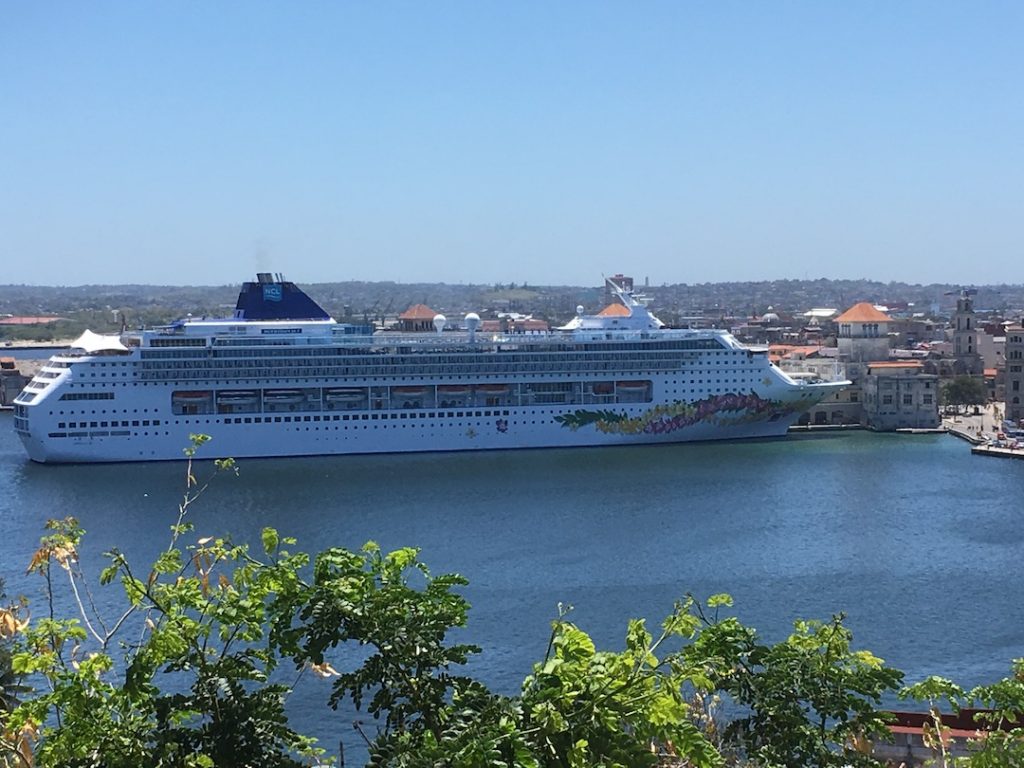
Photo Ben Pollock
If Monday was sailing to Cuba, then Thursday the 19th was spent enjoying a small island owned by the cruise line. We walked around its coves and enjoyed a picnic lunch with several hundred of our fellows.
Yet I struggled to enjoy, as a cold started the evening before. No seasickness but sniffles, but at least it started hours after the Cuba port of call ended.
Overall, ship staff was attentive, not intrusive and not distant. It was easy to eat healthy.
A handful of the ship’s wait staff each night were called to sing people “Happy Birthday.” At least one server, every time, was remarkably tone deaf. On Tuesday night we were serenaded with an anniversary song, similarly out of tune. The selection? “Let Me Call You Sweetheart,” just one verse and chorus fortunately. Thursday was our official anniversary (as far as ship staff were concerned), and we got sung to again.
Early Friday we arrived back in Miami. Eying a late afternoon flight to Northwest Arkansas Regional, I figured out how to squeeze out another vacation day. We took the cruise line’s bus to the airport, where we splurged and paid to check our bags. Then we took an Uber to South Miami Beach.
The plan was to enjoy the famous South Beach with a lunch at News Cafe, which we remembered fondly from our fifth anniversary trip, a few days in Miami. The restaurant and its staff as before were full of personality serving moderately priced, tasty, large portions. We had the Middle Eastern Platter for Two (dolma, baba ghanoush, hummus, tabbouli and some hot tomato red spice paste). On their sound system — Louis, Ella and French midcentury pop songs. MB raved about News Cafe’s Key lime pie, made with sweetened condensed milk, rather than the conventional custard or, rather deceptively, the lime-flavored and -colored cheesecake she’s been served for years almost everywhere else.
Then we took off our shoes and walked along the beach. Seeing an airplane-towed banner — “Shoot Machine Guns – @ Lock and Load Miami – Firearms Museum” — reminded us we had returned to the USA in 2018.
Photo Ben Pollock
Photo Ben Pollock
“The Goofus American” title is a reference to the novel and movie The Quiet American. Graham Greene’s classic tragedy actually is about Vietnam, while his comic Our Man in Havana is set in this hemisphere. Great casts in both film adaptations.
© 2018 Ben S. Pollock
